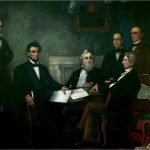On the afternoon of January 1, 1863, President Abraham Lincoln signed The Emancipation Proclamation, freeing approximately three million people held in bondage in the rebel states of the Confederacy. The Emancipation Proclamation was a huge step towards rectifying the atrocity of institutionalized slavery in the United States, but it was only one step and it had a mixed legacy, as the four essays by UT Austin historians in this month’s feature remind us.
George Forgie discusses the political wrangling that accompanied the Emancipation Proclamation, the work it left undone, and the need – that seems so obvious today, but was so deeply contested at the time – for a law abolishing slavery altogether.
Jacqueline Jones takes us right into Savannah’s African American community on New Year’s Eve, to see and hear how Black Americans there anticipated the momentous news.
Laurie Green brings us up to 1963 to show us how civil rights activists in the 1960s saw the work of the Emancipation Proclamation as still unfinished. One hundred years after it was signed, they viewed the civil rights movement as an effort to fulfill its original intent to bring not only legal freedom, but economic justice and individual dignity to the descendants of US slaves.
Daina Ramey Berry looks at Quentin Tarantino’s sensationalist and willfully inaccurate treatment of slavery in Django Unchained and she offers us alternative sources for learning about the historical violent abuses of slave life.
Juliet E. K. Walker examines the contrast between the legal and economic consequences of the Emancipation Proclamation.
You may also enjoy:
A brief history of the text and alternate versions on The National Archives website.
Eric Foner, “The Emancipation of Abe Lincoln,” The New York Times, January 1, 2013.
Additional links and readings can be found in each of the articles in this feature
Photo Credits:
Printed Reproduction, Emancipation Proclamation, Wikimedia Commons



